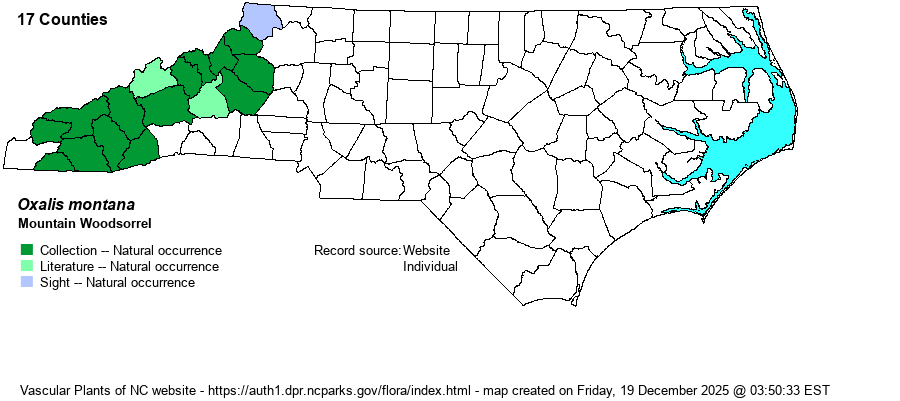| Author | Rafinesque | |
| Distribution | Essentially throughout the Mountains, but scarce or absent in several counties that lack high elevations (as this species grows mainly above 4500 feet in elevation).
This is a Northern species, ranging from eastern Canada south to PA, and in the Appalachians south to western NC and eastern TN, disjunctly to GA.
| |
| Abundance | Fairly common within its limited habitat, though scarce as a whole over the Mountains. | |
| Habitat | This is a species of cold to cool forests, at high elevation. It grows best in spruce-fir forests, but it does occur lower into Northern Hardwood Forests and other high elevation forest types. |
| Phenology | Blooms mainly from May to July, and fruits shortly after flowering. | |
| Identification | This is our only white-flowered woodsorrel, all others having yellow or rose-purple flowers. It grows to only 4-6 inches tall, in dense patches along a rhizome. The leaves are all basal, arising from this rhizome, but the structure of them is like others in the genus -- 3 clover-like leaflets on long petioles. The flowers arise from the rhizome, on long stalks, topped by a "large" (for an Oxalis) white flower of 5 petals, about 1-inch across. Most significantly, the base of each petal is bright rose-red, and veins are also this same color, yielding a very striking rose and white flower that simply cannot be overlooked in the deep shade of a spruce-fir forest. | |
| Taxonomic Comments | The species was formerly named as O. acetosella.
| |
| Other Common Name(s) | White Woodsorrel, Common Woodsorrel, Wood Shamrock | |
| State Rank | S3 | |
| Global Rank | G5 | |
| State Status | | |
| US Status | | |
| USACE-agcp | | |
| USACE-emp | FAC link |

